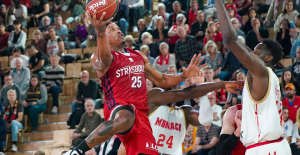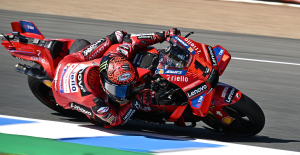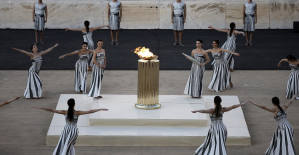Even the journey to the arrival guides you into other spheres: On the route between the Lefka Ori, the White Mountains, and the Askifou plain, the road leads after a few minutes along an almost bottomless gorge, clinging to mountain slopes whose rocky outcrops literally over the grow head. Although Greece's largest island is nowhere wider than 60 kilometers, it looks like its own continent when you cross it.
The further and higher you go, the more deserted the villages are, until at some point only flocks of sheep cross the path; they have transformed the highest elevations into barren lunar landscapes, on which only the occasional broom or thyme bush blooms. Then it goes back down towards the sea - and to the actual starting point.
Away from culture and tourism in Crete's north, perhaps the most beautiful part of the island is its south, where nature presents itself in a confined space with the most diverse topography and flora, while not even many locals are out and about there anymore. The beaches and bays on the south coast are in no way inferior to those in the north and east - and also house a gem where the limited travel and entertainment options exude the charm of seclusion and nothingness: Loutro.
The place can only be reached by boat. There is little reason to bother making the crossing, as Loutro has no sights or activities to offer. But that is exactly what appeals to some vacationers. Us too.
We are in the port of Chóra Sfakíon. There are no regular timetables, just a blackboard with faded writing that someone left with chalk. We gather from the writing that the next ferry to Loutro leaves in three hours – theoretically. The place is deserted, only a goat bleats down from a ledge.
The apparently only person in town sits in a fisherman's house at the end of the quay. He comes along like a real sea dog, wears a full gray beard and a navy-colored sweater, although it is already very warm outside. His skin is tanned by the sun; like many islanders, he has North African features, except for his eyes, which are light blue and have a sleepy emptiness.
When asked how to get to Loutro, he laconically replies, only with him. But he just doesn't feel like it. And if we did, we would have to pay him 70 euros, but the return trip was already included in the price. When we try to bargain with him, he gets up, goes outside and lights a cigarette. The sea dog got the hang of it; A little later we are sitting in his small motorboat, 70 euros poorer.
The crossing takes less than twenty minutes. The Libyan Sea shines turquoise blue, we glide gently over it, we get into a Robinson Crusoe-like travel mood. The sea in the south of the island is very different from the rough Cretan Sea in the north, which gives the impression of being in the Odyssey.
Sheep occasionally graze on the hillsides above the coast, while below cave entrances and miniature beaches appear here and there, with no obvious access to civilization. Then white little houses appear in the distance, slowly getting bigger in front of the bow.
The reception when docking in Loutro is prepared by an angular, evil-looking man. He is dressed entirely in black; all of his limbs have tattoos, none of which reveal what they represent. His black hair is held back by a black cloth. He also has a full beard. All he needs for a coherent pirate outfit is an eye patch.
Without a word, he approaches the boat. With a slight nod, the ferryman hands us his business card; we could call him if we want to drive back, at best with other day trippers please. Then he disappears together with the other sea dog.
Loutro has little more than 80 residents, even in high season; it consists of no more than two rows of houses, with the front row housing mainly guesthouses. There are still two small grocery stores and a kind of village mascot, the parrot of the hotel "Porto Loutro"; but the bird is as taciturn as the natives.
You will look in vain for monuments or similarly conspicuous objects, as well as ATMs or place-name signs. Whatever the reason, there are no roads leading to Loutro. A tour of the site takes about five minutes. But at the latest when you have arrived back at the crescent-shaped bay, you have lost all sense of time.
We find a dirt track winding up the slope behind Loutro. From above it becomes even clearer how peaceful and secluded the village is; only Gavdos moves into view. The tiny Greek island is geographically considered to be the southernmost point of Europe, with Africa beginning somewhere behind it.
Back in the village, a hotel owner tells us that there have been repeated attempts to build a road to Loutro. The residents would have prevented this but always, sometimes violently. On Crete, the Greeks defend their interests even more rigorously than on the mainland, which perhaps explains the martial appearance of the ferrymen.
If you stroll through Loutro, you will inevitably come to a stop in front of the tavern on the jetty. The opening hours are flexible. If you sit down on a chair, the tavern opens and the owner comes. The furniture consists of Greek kafenion chairs and Chinese plastic tables. All around, flowers are sprouting from empty olive oil canisters. Wind chimes made of shells waft above the tables.
There is no menu, the daily specials are presented in a display: pork chops with oregano, lamb pie, plus the island's national dish, dakos, moistened barley bread with tomatoes, olive oil and feta, probably everything from the neighboring mountains.
After a frappé, the small stone beach at the entrance to the village invites you to take a nap. A few small kaíkis are at anchor. Sleep, eat, coffee and then sleep again - Loutro's rhythm is quickly internalized.
There is also a catalog beach made of sand, but a little further out. The protected location speaks for the small stony bay; the waves that hit the shore are correspondingly small. This is easy on the eyes, ears - and on the muscles when swimming. You feel like you're lying on clouds.
In the evening, when the skipper welcomes us again, a smile appears on his face for the first time. His daily income has skyrocketed because more Loutro visitors are standing at the jetty. When you look back, the houses shrink. Loutro fades. It almost seems as if the hamlet was just an illusion, a surreal dream of ancient Greece.
Arrival: For example with Eurowings, Condor or Ryanair to Chaniá. From there by rental car or intercity bus to Chóra Sfakíon. From here there is theoretically a ferry connection to Loutro, but you should not rely on it. If you use the service of a water taxi instead, you have to reckon with 35 euros per person for the 20-minute crossing.
Accommodation: If you want to stay overnight, you can find all the hotels on loutro.gr, prices for a double room in the season from 50 euros per night.
Island reading: Nikos Kazantzakis: "Alexis Sorbas", Rowohlt paperback, 9.95 euros
Information: visitgreece.com.de
This article was first published in 2019.

 War in Ukraine: when kyiv attacks Russia with inflatable balloons loaded with explosives
War in Ukraine: when kyiv attacks Russia with inflatable balloons loaded with explosives United States: divided on the question of presidential immunity, the Supreme Court offers respite to Trump
United States: divided on the question of presidential immunity, the Supreme Court offers respite to Trump Maurizio Molinari: “the Scurati affair, a European injury”
Maurizio Molinari: “the Scurati affair, a European injury” Hamas-Israel war: US begins construction of pier in Gaza
Hamas-Israel war: US begins construction of pier in Gaza First three cases of “native” cholera confirmed in Mayotte
First three cases of “native” cholera confirmed in Mayotte Meningitis: compulsory vaccination for babies will be extended in 2025
Meningitis: compulsory vaccination for babies will be extended in 2025 Spain is the country in the European Union with the most overqualified workers for their jobs
Spain is the country in the European Union with the most overqualified workers for their jobs Parvovirus alert, the “fifth disease” of children which has already caused the death of five babies in 2024
Parvovirus alert, the “fifth disease” of children which has already caused the death of five babies in 2024 Inflation rebounds in March in the United States, a few days before the Fed meeting
Inflation rebounds in March in the United States, a few days before the Fed meeting Video games: Blizzard cancels Blizzcon 2024, its annual high mass
Video games: Blizzard cancels Blizzcon 2024, its annual high mass Falling wings of the Moulin Rouge: who will pay for the repairs?
Falling wings of the Moulin Rouge: who will pay for the repairs? “You don’t sell a company like that”: Roland Lescure “annoyed” by the prospect of a sale of Biogaran
“You don’t sell a company like that”: Roland Lescure “annoyed” by the prospect of a sale of Biogaran Exhibition: in Deauville, Zao Wou-Ki, beauty in all things
Exhibition: in Deauville, Zao Wou-Ki, beauty in all things Dak’art, the most important biennial of African art, postponed due to lack of funding
Dak’art, the most important biennial of African art, postponed due to lack of funding In Deadpool and Wolverine, Ryan and Hugh Jackman explore the depths of the Marvel multiverse
In Deadpool and Wolverine, Ryan and Hugh Jackman explore the depths of the Marvel multiverse Tom Cruise returns to Paris for the filming of Mission Impossible 8
Tom Cruise returns to Paris for the filming of Mission Impossible 8 Skoda Kodiaq 2024: a 'beast' plug-in hybrid SUV
Skoda Kodiaq 2024: a 'beast' plug-in hybrid SUV Tesla launches a new Model Y with 600 km of autonomy at a "more accessible price"
Tesla launches a new Model Y with 600 km of autonomy at a "more accessible price" The 10 best-selling cars in March 2024 in Spain: sales fall due to Easter
The 10 best-selling cars in March 2024 in Spain: sales fall due to Easter A private jet company buys more than 100 flying cars
A private jet company buys more than 100 flying cars This is how housing prices have changed in Spain in the last decade
This is how housing prices have changed in Spain in the last decade The home mortgage firm drops 10% in January and interest soars to 3.46%
The home mortgage firm drops 10% in January and interest soars to 3.46% The jewel of the Rocío de Nagüeles urbanization: a dream villa in Marbella
The jewel of the Rocío de Nagüeles urbanization: a dream villa in Marbella Rental prices grow by 7.3% in February: where does it go up and where does it go down?
Rental prices grow by 7.3% in February: where does it go up and where does it go down? Even on a mission for NATO, the Charles-de-Gaulle remains under French control, Lecornu responds to Mélenchon
Even on a mission for NATO, the Charles-de-Gaulle remains under French control, Lecornu responds to Mélenchon “Deadly Europe”, “economic decline”, immigration… What to remember from Emmanuel Macron’s speech at the Sorbonne
“Deadly Europe”, “economic decline”, immigration… What to remember from Emmanuel Macron’s speech at the Sorbonne Sale of Biogaran: The Republicans write to Emmanuel Macron
Sale of Biogaran: The Republicans write to Emmanuel Macron Europeans: “All those who claim that we don’t need Europe are liars”, criticizes Bayrou
Europeans: “All those who claim that we don’t need Europe are liars”, criticizes Bayrou These French cities that will boycott the World Cup in Qatar
These French cities that will boycott the World Cup in Qatar Basketball: Strasbourg appeals the victory recovered by Monaco
Basketball: Strasbourg appeals the victory recovered by Monaco Top 14: UBB with Tatafu and Moefana against Bayonne
Top 14: UBB with Tatafu and Moefana against Bayonne MotoGP: Bagnaia dominates qualifying practice in Spain and sets track record
MotoGP: Bagnaia dominates qualifying practice in Spain and sets track record Olympic Games: in Athens, Greece transmits the Olympic flame to France
Olympic Games: in Athens, Greece transmits the Olympic flame to France


















